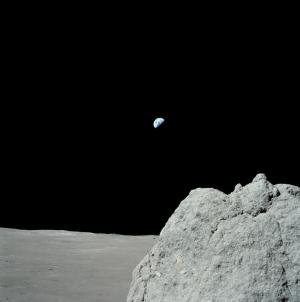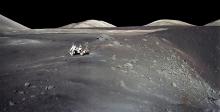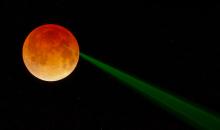Earth hangs above a large boulder examined by Apollo 17 astronauts Gene Cernan and Jack Schmidt in December 1972. A recent analysis of freshly opened samples from Apollo 17 found that the Moon is at least 4.46 billion years old, or roughly 40 million years older than revealed by other samples. [NASA]
You are here
Moon and Gemini
ASTRONAUTS: There’s a chunk there that we can get. That’s a big fragment within this crystalline rock. Take a picture of that…
Apollo 17 astronauts Gene Cernan and Jack Schmitt were chipping samples from a large boulder. It was at the base of a cliff, in a region of the Moon known as Taurus-Littrow.
ASTRONAUTS: They’re very reflective, elongated crystals. It’s relatively angular inclusions. It’s about half a meter in size, and it’s a square cross section.
Scientists recently got the chance to study part of one of those chips for the first time. They found that it contained the oldest piece of the Moon yet seen — 4.46 billion years old. That’s 40 million years older than any other sample yet studied. It means that the Moon formed 40 million years earlier than suggested by earlier studies.
The Moon probably formed in a “Big Whack.” A planet as big as Mars rammed into the young Earth, blasting molten rock into space. Much of that material came together to form the Moon.
The Apollo 17 sample contained crystals that formed when the Moon cooled and solidified. Because it’s the oldest sample yet seen, it sets a minimum age for the Moon. It tells us that the Moon formed no more than 110 million years after the birth of the solar system — helping scientists time the Big Whack.
The Moon is in the east at nightfall. Pollux and Castor, the twins of Gemini, stand above it. The brighter twin, Pollux, is closer to the Moon.
Script by Damond Benningfield
Get Premium Audio
Listen to today's episode of StarDate on the web the same day it airs in high-quality streaming audio without any extra ads or announcements. Choose a $8 one-month pass, or listen every day for a year for just $30.







